

What’s in a name? When it comes to a mille-feuille, chefs play fast and loose with how they apply the term. The general consensus seems to be that the name originally referred to a pastry made of interleaving layers of baked pâte feuilletée (puff pastry), crème patisserie (pastry cream), and confiture d’abricot (apricot jam) — a “Napoleon” in English. Looking through various references, I’ve found no clear origin or inventor for this stack of air and sugar, or even a consensus as to its origins. The earliest published recipe I’ve found in my limited research was in Ali-Bab’s Gastronomie pratique, etudes culinaires suivies du Traitement de l’obésité des gourmands written in 1919. The 2001 English-language translation of the 1996 edition of the Larousse Gastronomique states “the origin of the mille-feuille dates back to the late 19th century.” (There is no statement like this in the original French-language version!)
In French, mille-feuille literally means “a thousand leaves.” It is thought that this refers to the approximate number of layers in the puff pastry used to make the pastry. This may be the traditional understanding, but in modern French cooking, other ingredients are now substituted for the puff pastry. It is not uncommon to find various “cookies” used instead of the puff pastry, and now that the term is also being applied to savory dishes as well as sweet dishes, the dividing ingredient may be animal or vegetable. In fact, the term is now applied to layered dishes of all types. Since the number of layers is often, but not always, three, I think that maybe the term should be changed to trois-feuille!
The subject of this article is desserts made with three layers. These desserts consist of some form of cookie along with some form of filling and fruit arranged in layers. There may or may not be additional flavors added in the form of sauces and other decorations displayed around or on the basic layered arrangement. Below are three possible examples that fit these criteria. (Click on the pictures for detailed descriptions of each combination.)
In the examples above, the cookie layer was pâte feuilletée (puff pastry), tuiles (flattened drop cookies), or baked crepes. Other possibilities are baked brik, baked filo pastry sheets, baked shredded filo pastry, or even thin wafers of tempered chocolate. The filling was crème chiboust (pastry cream lightened with egg whites), mousse au chocolat (chocolate pudding), or crème chantilly (whipped cream). Other possibilities for the filling include sorbet, ice cream, flavored or unflavored custard, various mousses (puddings), and crème patisserie (pastry cream) — straight or lightened with whipped cream. The fruits used were fresh raspberries, poached pears, and macerated blueberries, but almost any fruit in any usable form could be substituted. The finished dessert can be decorated in a multitude of ways including chopped nuts, fresh fruits, sauces and coulis. These trois-feuilles are truly examples of “mix and match.” Literally, there is almost an infinite number of combinations possible and surprisingly, many of them actually work.
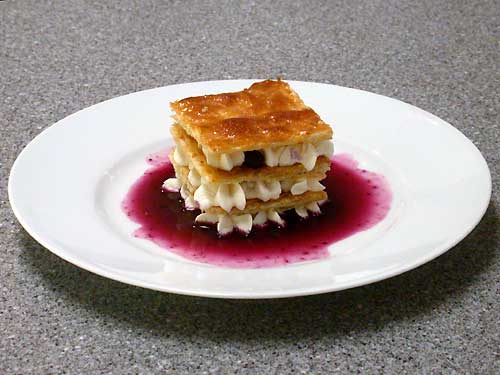
mille-feuille à la crème et myrtilles
Yield: 6 servings.

Crème chantilly is normally prepared with vanilla extract rather than the almond syrup used in this recipe. Other possibilities include walnut or almond extract, fruit-based syrups, or just about any other flavoring.
crème chantilly
Yield: 6 servings.
Ref: Joël Robuchon (ed), Larousse Gastronomique, page 346.

pâte feuilletée
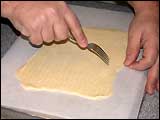
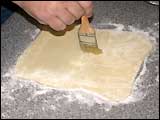
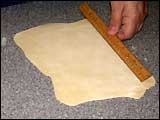
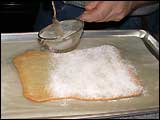 Remove the pastry from the oven and preheat broiler. Remove the top baking sheet and parchment paper. Liberally sprinkle powdered sugar over the hot pastry. Transfer pastry to a plain baking sheet without the parchment paper. Brown under the broiler for a short time until the sugar melts and begins to caramelize.
Remove the pastry from the oven and preheat broiler. Remove the top baking sheet and parchment paper. Liberally sprinkle powdered sugar over the hot pastry. Transfer pastry to a plain baking sheet without the parchment paper. Brown under the broiler for a short time until the sugar melts and begins to caramelize.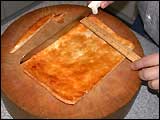 When cool, using a serrated knife, trim the edges of the pastry to produce a single 16 by 21-cm piece. Cut the pastry lengthwise into two 8 by 21cm pieces. Cut each of these pieces into three 7 by 8-cm pieces.
When cool, using a serrated knife, trim the edges of the pastry to produce a single 16 by 21-cm piece. Cut the pastry lengthwise into two 8 by 21cm pieces. Cut each of these pieces into three 7 by 8-cm pieces.Yield: 2 servings (6 pieces).
Ref: Bernard Loiseau, Cuisine en Famille, page 270; Georges Blanc, Cuisine en Famille, page 188; and Guide Cuisine, January 2001, page 14.

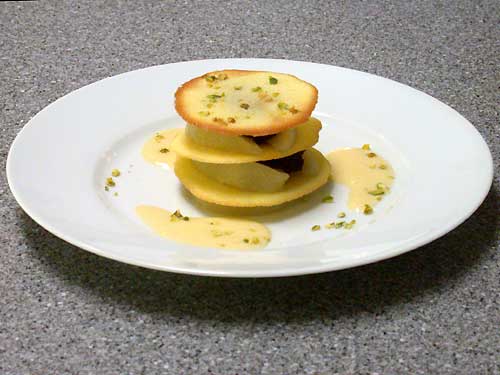
mille-feuille aux tuiles et mousse
Yield: 6 servings.

This version of chocolate mousse uses chocolate that is low in sugar to offset the sweetness of the rest of the mille-feuille. If prepared as a stand-alone dessert, use a chocolate with more sugar in it.
mousse au chocolat
Yield: 6 servings.
Ref: Joël Robuchon (ed), Larousse Gastronomique, page 692.

The following recipe can be varied by sprinkling various items — such as chopped or sliced nuts or citrus zests — on the dough after it is arranged on the baking sheet, but before baking. If the tuiles are going to be used as cookies rather than as part of a mille-feuille, drape the warm pastry over a curved surface, such as a rolling pin, to cool in their traditional shape.
tuiles
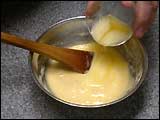
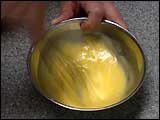 Whisk egg and sugar together until light in color. Using a wooden spoon, beat the flour and salt into the egg mixture. Finally, beat the butter into the batter.
Whisk egg and sugar together until light in color. Using a wooden spoon, beat the flour and salt into the egg mixture. Finally, beat the butter into the batter.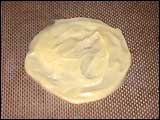
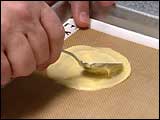 Drop 1 scant teaspoon portions (use a dessert spoon, not a measuring spoon) on a baking sheet cover with a silicon liner. Use the back of the spoon to spread the batter into even, 10cm diameter circles.
Drop 1 scant teaspoon portions (use a dessert spoon, not a measuring spoon) on a baking sheet cover with a silicon liner. Use the back of the spoon to spread the batter into even, 10cm diameter circles.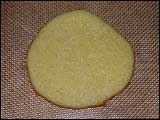
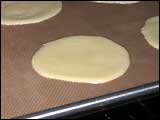 Bake the cookies for 4-1/2 minutes until the edges are slightly brown. Immediately transfer the cookies to cooking racks to cool.
Bake the cookies for 4-1/2 minutes until the edges are slightly brown. Immediately transfer the cookies to cooking racks to cool.Yield: 18 to 24 cookies.
Ref: Cuisine Actuelle, February 1999, page 7 and Guide Cuisine, July 2001, page 68.

The following combination of ingredients and their arrangement is similar to what I was served at Restaurant Patrick Jeffroy in October, 2001. Chef Jeffroy lightened his pastry cream with whipped cream rather than egg whites which yields a firmer result. He additionally applied a raspberry coulis around the final arrangement.
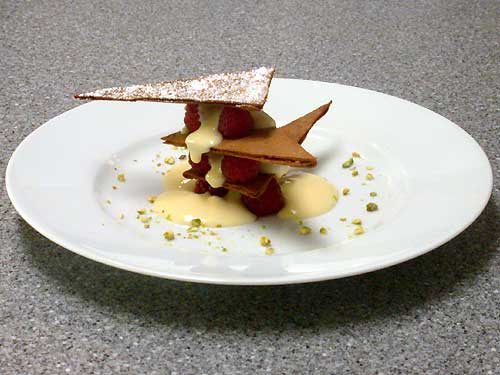
mille-feuille aux crêpes et crème
Yield: 6 servings.

The addition of bergamot oil as a flavoring to this filling is the creation of Chef Patrick Jeffroy of Carantec, France. Additionally, he sieved the pastry cream after it cooled and then lightened it with whipped cream rather than egg whites. This produced a firmer filling than the recipe below.
crème chiboust
Yield: 6 servings.
Ref: Cuisine Actuelle, April 2000, page 6 and Patrick Jeffroy, Restaurant Patrick Jeffroy, Carantec, France, October 2001.

crêpes
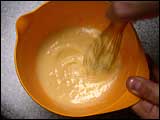
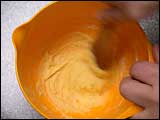 For crepe batter: mix flour, sugar, and salt. Add egg and mix with a wooden spoon. Slowly add milk and mix until smooth. Incorporate melted butter. Set batter aside for an hour before using.
For crepe batter: mix flour, sugar, and salt. Add egg and mix with a wooden spoon. Slowly add milk and mix until smooth. Incorporate melted butter. Set batter aside for an hour before using.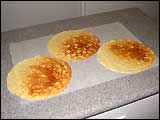
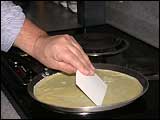 Preheat a large crepe pan. Using 90-ml portions of batter, make the 10-inch diameter crepes. Set aside to cool.
Preheat a large crepe pan. Using 90-ml portions of batter, make the 10-inch diameter crepes. Set aside to cool.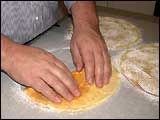
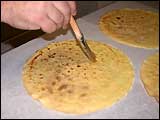 Lay a crepe on a sheet of parchment paper, worst-side-up. Brush the surface with melted butter. Sprinkle the buttered surface with powdered sugar. Fold the crepe in half and press the surfaces tightly together. Set aside and repeat for the other crepes.
Lay a crepe on a sheet of parchment paper, worst-side-up. Brush the surface with melted butter. Sprinkle the buttered surface with powdered sugar. Fold the crepe in half and press the surfaces tightly together. Set aside and repeat for the other crepes.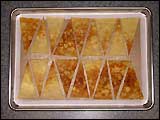
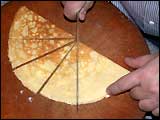 Cut each semi-circular crepe into 6 equal sectors. Trim the curve off each sector to make 6 isosceles triangles. Arrange the triangles on a baking sheet lined with a silicon baking liner, rough side up. Repeat for the other crepes. Cover the crepe triangles with an additional silicon baking liner, rough side down, to prevent curling.
Cut each semi-circular crepe into 6 equal sectors. Trim the curve off each sector to make 6 isosceles triangles. Arrange the triangles on a baking sheet lined with a silicon baking liner, rough side up. Repeat for the other crepes. Cover the crepe triangles with an additional silicon baking liner, rough side down, to prevent curling.Yield: 6 servings (18 pieces).
Ref: Patrick Joffroy, Restaurant Patrick Jeffroy, Carantec, France, October, 2001 and Cuisiner!, February 1997, page 16.

